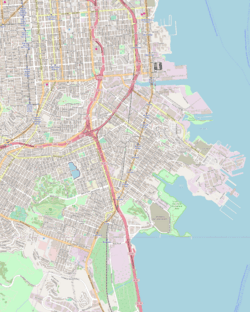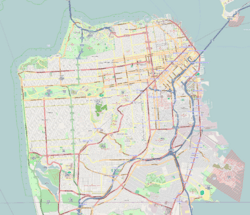Visitacion Valley, San Francisco facts for kids
Quick facts for kids
Visitacion Valley
|
|
|---|---|

Visitacion Valley viewed from Visitacion Ave is Mansell St by John McLaren Park.
|
|
| Nickname(s):
Viz Valley
|
|
| State | California |
| City | San Francisco |
| Area | |
| • Total | 1.582 sq mi (4.10 km2) |
| Population
(2008)
|
|
| • Total | 22,534 |
| • Density | 14,241/sq mi (5,498/km2) |
| Time zone | UTC-8 (PST) |
| • Summer (DST) | UTC-7 (PDT) |
| ZIP Code |
94134
|
| Area codes | 415/628 |
Visitacion Valley (VIZ-i-TAY-shən; Spanish: Valle de la Visitación), colloquially referred to as Viz Valley, is a neighborhood located in the southeastern quadrant of San Francisco, California.
Visitacion Valley is roughly defined by McLaren Park and Gleneagles Golf Course to the West, Mansell Blvd and Portola to the north, Bayview Hill and Candlestick Cove to the east, and the San Francisco / San Mateo County line to the south. The streets of this neighborhood straddle the border between San Francisco and Daly City, hence partially blending with the adjacent Daly City neighborhood of Bayshore. The grounds of the Cow Palace, straddling the San Francisco/Daly City border, are partially within Visitacion Valley.
Contents
Name
Visitacion Valley takes its name from Rancho Cañada de Guadalupe la Visitación y Rodeo Viejo, a large tract of land that also included the Bayshore district of Daly City, the city of Brisbane, and San Bruno Mountain.
The term "Visitation" is derived from the Bible. Mary, bearing the child Jesus in her womb goes to visit her cousin Elizabeth who despite her advanced years is pregnant with John the Baptist. John who would become the greatest of prophets jumps in Elizabeth's womb as Mary walks in the door, knowing he is in presence of the Savior. Luke 1:39
Attractions and characteristics
The area is a largely family-oriented working-class neighborhood. Average Adjusted Gross Incomes for the area are at $38,802, much lower than the citywide average of $73,798. Median rents in 2007 for the neighborhood at $896 a month are also far below the citywide average at $1,141.
The area was originally settled by Irish and Italian immigrants who worked in the nearby factories. The construction of the nearby Hunters Point Naval Shipyard during World War II, led to a massive influx of African Americans who worked in the shipyards. Many settled in the Sunnydale Projects which were originally constructed as barracks to house workers. After the war ended, more African Americans relocated from the Fillmore District and the Western Addition because redevelopment programs provided inexpensive housing. The area still has a 30% African American population; however, this number has been declining in recent years due to the rising cost of living in San Francisco and black flight to the East Bay area. The Black population is being supplanted by an influx of ethnic Chinese immigrants who now make up more than half of the neighborhood's population.
The former barracks turned housing projects on Sunnydale Avenue, the Sunnydale Projects is the largest in San Francisco and remains one of the most violent areas of the city. The two high-rise apartment buildings, Geneva Towers, originally built as private housing in the 1960s, were converted to public housing in the 1970s. They suffered through dilapidation and poor maintenance throughout the 1980s, and were plagued by gangs and drug activity. The City ordered the destruction of the buildings in 1998, and replaced them with lower-density units. The Visitacion Valley Redevelopment Area for the area centering at Leland Avenue and Bayshore Boulevard, including the former Schlage Lock Factory, was adopted by the Board of Supervisors in April 2009. A transit-oriented mixed-use development (Visitacion Valley TOD Project) will be constructed on the former Schlage Lock Factory and Southern Pacific Railyard following demolition of existing buildings, except for the Historic Office Building, and brownfield remediation, which started after Remediation Action Plan was approved on November 16, 2009. This project will feature a grocery store, condos, parks, and other new redevelopment designed to revitalize the neighborhood.
The Chinese American residency has grown and more businesses have opened on Leland Avenue, the location of the Visitacion Valley Street Fair which began in the mid-2000s.
Redevelopment also came in the construction of a new Muni Metro line called the T Third Street, which terminates at Sunnydale Station. The extension into the neighborhood is part of a major project to ultimately extend Muni to the northeast section of the city, thus granting easy and faster access for the neighborhood's Chinese residents to Chinatown, and for future development along Third Street.
The Old Visitacion Valley Branch of San Francisco Public Library used to be at a small storefront located at 45 Leland Ave at Desmond Street. The newer one is now on Leland and Rutland and finished construction in the summer of 2011.
Education
Elementary
- Visitacion Valley Elementary School
- El Dorado Elementary School
Middle School
- Visitacion Valley Middle School
- Our Lady of the Visitacion School (K–8)
Notable past residents
- Peter Hardeman Burnett, California governor (1849–1851)
- Rikishi (Solofa F. Fatu Jr.), American professional wrestler
- Dan White, San Francisco supervisor who assassinated Supervisor Harvey Milk and Mayor George Moscone in 1978
Images for kids









